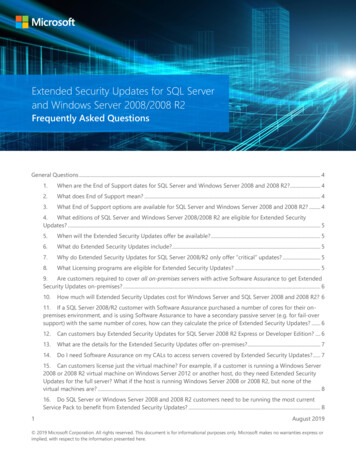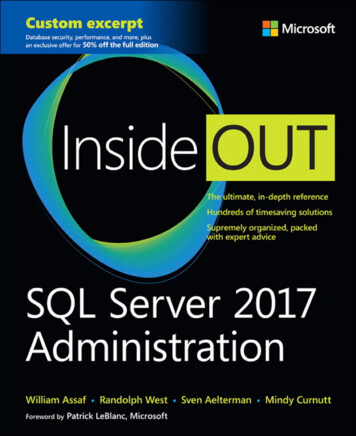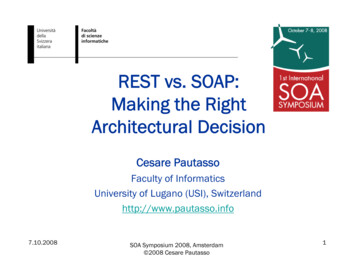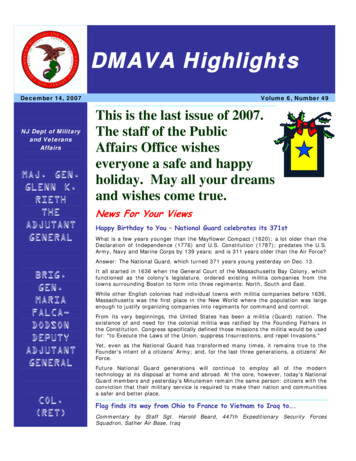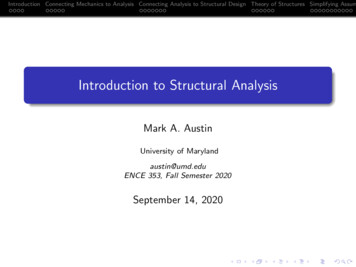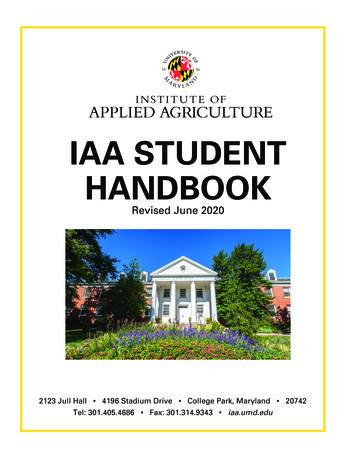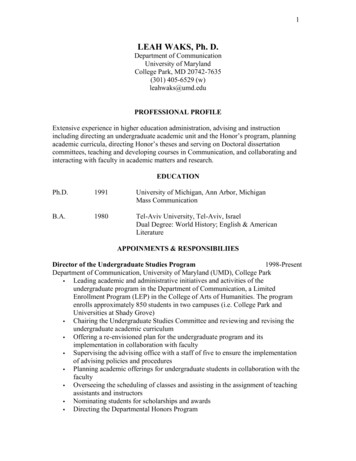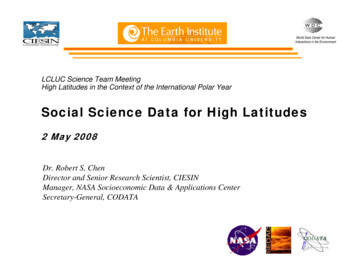
Transcription
World Data Center for HumanInteractions in the EnvironmentLCLUC Science Team MeetingHigh Latitudes in the Context of the International Polar YearSocial Science Data for High Latitudes2 May 2008Dr. Robert S. ChenDirector and Senior Research Scientist, CIESINManager, NASA Socioeconomic Data & Applications CenterSecretary-General, CODATA
Main Sources of Socioeconomic Data Data Types– Censuses, surveys, registries– Administrative & transactionalrecords– Ground-based studies & surveys– In situ sensors, monitors– Field reports, records– Press reports– Maps World Data Center for HumanInteractions in the EnvironmentData Sources– Governments Multinational agencies (UN) National-level governmentagencies State and local– Nongovernmental organizations– Research communities– Business2
Traditional View of the World by Country 192 United Nationsmember states, rangingfrom:– Tuvalu with 10,000people and just 32 km2– China with 1.28 billionpeople and 9.2 millionkm2– Russia with 16.7million km2 Subnational data moredifficult to collect andcompare– Szechuan Province ofChina about same sizeand population asFranceWorld Data Center for HumanInteractions in the Environment
Subnational Administrative Boundary andPopulation Density DataWorld Data Center for HumanInteractions in the Environment
Arctic Urban Extents from GRUMPWorld Data Center for HumanInteractions in the Environment GRUMP Global Rural Urban Mapping Project Combines stable night lights with administrative boundary and population– Settlement points– Urban extents– Urban-rural gridded population density5
Urban SettlementsGlobal Rural Urban Mapping Project (GRUMP)http://sedac.ciesin.columbia.edu/gpw/World Data Center for HumanInteractions in the Environment6
Distribution of Recent Population GrowthWorld Data Center for HumanInteractions in the Environment Coastal and island areasunder extreme pressure;some are veryvulnerable Cultivated areas secondin terms of growth inpopulation density Polar regionsexperiencing a decreasein total population
The Human Footprint, Version 2 80% of world’s land surface has been significantly altered by direct human transformationWorld Data Center for HumanInteractions in the Environment
The Last of the Wild, Version 2World Data Center for HumanInteractions in the Environment9
Natural Disaster Hotspots – ExposureHazards examined: drought, flood, landslides, earthquakes, volcanoes, cyclonesWorld Data Center for HumanInteractions in the Environment
Natural Disaster Hotspots – MortalityWorld Data Center for HumanInteractions in the Environment Areas of high relative risk based on historic mortality
Natural Disaster Hotspots –Economic LossesWorld Data Center for HumanInteractions in the Environment Areas of high relative risk based oneconomic losses Areas of high relative risk based on historic loss data12
PLACE II Data SetWorld Data Center for HumanInteractions in the Environment Summary statistics for 228 nations,1990 and 2000 Land and population by zones ofpopulation density, coastal proximity,climate, elevation and biomes Map galleryhttp://sedac.ciesin.columbia.edu/place/13
Environmental Sustainability DataWorld Data Center for HumanInteractions in the Environment Ranks countries byprogress towardsenvironmentalsustainability14
IPCC Socioeconomic Data DistributionCentre Special Report on EmissionsScenarios (SRES) data IS92 scenarios Baseline socioeconomic datasets New observed climate impactsdatabase (in process) Possible new scenario World Data Center for HumanInteractions in the Environment
Past Emerging Infectious Disease Events 355 EID eventsgeoreferenced Reporting biascorrected for Hypothesizeddrivers overlaid RelationshipsanalyzedstatisticallyWorld Data Center for HumanInteractions in the Environment
Global Roads Data Under DevelopmentWorld Data Center for HumanInteractions in the Environment No recent publicdomain intercity roadsdata for research andapplications CODATA WorkingGroup formed Alternativeapproaches beingexplored, e.g.:––––ASTER algorithmGPS, Landsat, mapsOpen Street Map modelData buy fromcommercial sources– Some combination17
IPY Data and Information ServiceWorld Data Center for HumanInteractions in the Environment IPY data accessorganized by IPYDIS– Co-chairs, Mark Parsons& Taco de Bruin– Also a CODATAWorking Group IPYDIS is workingwith World DataCenter System toprovide data supportto “orphaned” IPYprojects CIESIN WDCplanning to workwith up to 4 groupsIPYDIS Directory: http://ipydis.org/community/directory.html18
CAVIAR: Community Adaptation &Vulnerability in Arctic RegionsWorld Data Center for HumanInteractions in the Environment Eight countries involved Set of case studies focused onpeople & livelihoods in communitycontext– Current and future exposure and sensitivity– Current and future adaptive capacities Data from interviews, focus groups,participant observations, selected“informants”, archival records,secondary sources19
DADDI: Discovery, Access, and Delivery ofData for IPYWorld Data Center for HumanInteractions in the Environment NASA ACCESS projectinvolving 3 data centers– NSIDC– ORNL– SEDAC Third year just begun– Reduced funding– Focused on OGCcompliant datavisualization and access– Integrated social andEarth science data20
DADDI “Working Prototype” Search SystemWorld Data Center for HumanInteractions in the Environment Currentlysearches 4catalogs:––––NSIDCCIESINCCINGCMD Based onORNL’sMercurySystem21
Example DADDI Search ResultsWorld Data Center for HumanInteractions in the Environment Simplefiltering ofresults Relevanceindicator Links todata22
SEDAC Polar Map Viewer PrototypeWorld Data Center for HumanInteractions in the Environment SupportsWMS, WFS,WCS SupportsWeb MapContext(WMC) Working onprojectionissues23
Service Interoperability Demo at GeoNorthConference in Yellowknife, CanadaWorld Data Center for HumanInteractions in the Environment Open Compusult Web Map Context (WMC) document in SEDAC mapping client24
Additional Data Layers: Caribou &PermafrostWorld Data Center for HumanInteractions in the Environment Caribou sightings duringthe calving season (fromCARMA via CubewerxWMS) Permafrost Extent from ArcticClimate Impact Assessment25
Gaia client: SEDAC’s urban extent vectorsand populated places served via WFSWorld Data Center for HumanInteractions in the Environment26
Permafrost and Population Data viaGoogle EarthWorld Data Center for HumanInteractions in the Environment SEDAC andNSIDC dataserved viaWMS Simple KMLfile to provideaccess to data
Desktop Mapping Application: TerraViva!SEDACWorld Data Center for HumanInteractions in the Environment New versionof TerraViva!SEDACavailable in aweek or so Providesvisualizationof multipleSEDAC andremotesensingdatasets inintegrateddesktopapplication
GEOSS RegistryWorld Data Center for HumanInteractions in the Environment29
Agreed GEO Data Sharing PrinciplesWorld Data Center for HumanInteractions in the Environment There will be full and open exchange of data, metadata, andproducts shared within GEOSS, recognizing relevant internationalinstruments and national policies and legislation. All shared data, metadata, and products will be made available withminimum time delay and at minimum cost. All shared data, metadata, and products being free of charge or nomore than cost of reproduction will be encouraged for research andeducation.GEOSS 10-Year Implementation Plan, adopted 16 February 2005(emphasis added)30
CODATA’s Role in GEOWorld Data Center for HumanInteractions in the Environment In 2006, CODATAagreed to take on GEOTask DA-06-01– Task extended into 2007-09GEO Work Plan Task web site available at:– http://www.codata.org/GEOSS31
Proposed Guidelines in 8 AreasWorld Data Center for HumanInteractions in the Environment1) Promoting implementation of the GEOSS Data Sharing Principles through thefull and open exchange of data2) Encouraging GEOSS users to reuse and re-disseminate shared data3) Ensuring consistency with other national laws and policies and internationalagreements4) Implementing pricing policies consistent with the GEOSS Data SharingPrinciples5) Reducing the time delays for making data available through GEOSS6) Promoting research and education uses of GEOSS data7) Developing metrics and indicators for GEOSS data sharing activities8) Developing effective coordination and outreach mechanisms forimplementing the GEOSS Data Sharing Principles32
Longevity of Selected Universities,Government Agencies, and Other InstitutionsWorld Data Center for HumanInteractions in the EnvironmentHarvard, 1636William & Mary, 1693Yale, 1701U. Penn, 1740Princeton, 1746Columbia, 1754Brown, 1764Rutgers, 1766Dartmouth, 1769UNC, 1795U. Maryland*, 1859MIT, 1865Stanford, 1891Treasury, 1789Library of Congress, 1800Smithsonian Inst., 1846NAS, 1863AMNH, 1869Dept. of Commerce, 1903NY Public Library, 1911ICSU, 1931NARA, 1934NSF, 1950NASA, 1958World Data Centers, 1958NSSDC, 1966CODATA, 1966155016001650170017501800Year1850190019502000* Started as Maryland Agricultural College; Prep school during 1864-66205033
Thanks!World Data Center for HumanInteractions in the Environment SEDAChttp://sedac.ciesin.columbia.edu CIESIN WDChttp://www.ciesin.columbia.edu/wdc IPY DIS– http://ipydis.org/index.html DADDI– http://www.nsidc.org/daddi CODATA– http://www.codata.org/34
DADDI: Discovery, Access, and Delivery of Data for IPY NASA ACCESS project involving 3 data centers -NSIDC -ORNL - SEDAC . (WMC) Working on projection issues 23. World Data Center for Human . remote sensing datasets in integrated desktop application.




